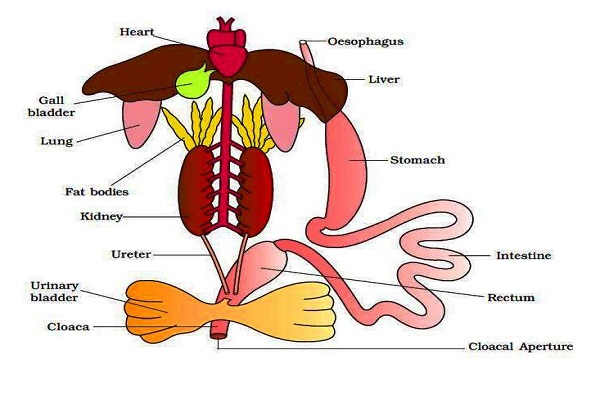PHYSIOLOGY OF DIGESTION IN FROG
PHYSIOLOGY OF DIGESTION IN FROG
Food and feeding
The adult frog is carnivoruous which feeds upon small insects, worms, snails etc. However, the tadpoles are herbivorous: feeding on aquatic plants.
Ingestion
The process of taking of food into alimentary canal through mouth is called ingestion. The food is captured with the help of sticky tongue. During ingestion, mouth is opened and the tongue is released out to catch the prey which is then rapidly withdrawn into the buccal cavity and mouth is closed.
The movement by which the food passes in the oesophagus and the rest of the alimentary canal. This process is called peristalsis.

Digestion
The process of breaking down of complex food into simple soluble and diffusible form with the help of their respective enzymes are called digestion.
Digestion of food in Bucco-pharynx
Bucco-pharyngeal cavity does not secrete any enzymes. Hence, no enzymatic digestion takes place in buccal cavity.
Digestion in Oesophagus
The mucus of the wall of oesophagus helps to lubricate and moisten the food. Enzymes are absent. The food lowers down with the help of peristalsis.
Digestion in stomach
The digestion start in stomach firstly breaking down into small pieces by muscular action and then by gastric juice.
The presence of food in stomach produce gastrin hormone which stimulates the gastric gland to secrete gastric juice. The gastrin also regulates the secretion of HCL which is produced from oxyntic cell.
Function of HCL
- It kills harmful bacteria and fungi
- It provides acidic medium which is necessary for the action of pepsin.
- It activates the enzymes (converts inactive pepsinogen into active pepsin).
Gastric juice contains pepsinogen. Pepsinogen changes into active form pepsin in acidic medium. Pepsin hydrolyze the protein content of food into soluble peptones and proteases.
Pepsinogen (inactive) + HCL Pepsin (active)
Pepsin + Proteins Proteases + Peptones
The carbohydrates and fats remain unaffected by pepsin.
The partial digested food is converted into semi-solid state called as chyme which is acidic. The food remains for about 2-3 hours in stomach and the digested food is absorbed while the remaining food is passed into duodenum.
Digestion in duodenum
The chyme enters the duodenum through the pyloric valve. In duodenum, the food is acted upon by the combined action of bile and pancreatic juice and intestinal juice. The acidified chyme stimulates the mucosa of duodenum to secrete the hormone secretin and cholecystokinin. Secretin stimulates the pancreas to secrete pancreatic juice. Also, cholecystokinin diffuses into blood circulation and reaches gall bladder to contract and pour bile into duodenum through hepatopancreatic duct.
Bile: It is an alkaline fluid which is secreted by liver.
It has no chemical action on food but it helps in neutralizing the acidic food.
It helps in emulsification of fats and breaks them into fine droplets.
It also provides alkaline medium necessary for the action of the enzymes present in the pancreatic and intestinal juice.
Pancreatic juice: It consists of three enzymes such as trypsinogen, amylase and lipase. These enzymes act best in an alkaline medium and hydrolyze the food.
Trypsinogen + Enterokinase Trypsin
Proteases + Trypsin Aminoacid
Starch + Amylopsin Maltose
Fats + Lipase Fatty acids + Glycerol
Digestion in ileum
The juice of ileum is succus entericus secreted by intestinal glands. It contains several enzymes such as enterokinase, erepsin, maltase, lipase, sucrase
Proteases + Erypsin Amino acid
Maltose + Maltase glucose
Fat + Lipase Fatty acids + Glycerol
Sucrose + Sucrase simple sugar glucose
Absorption, Assimilation and Egestion of food
All the digested food materials are absorbed mainly in duodenum and ileum due to the presence of villi. The villi increase the absorptive surface area. The amino acids, glucose, fructose are absorbed at the top and bottom of villi whereas fatty acid and glycerol are absorbed in lymph vessels called lacteals. Finally, the digested food is distributed by the blood to different tissue and cells which takes part in metabolic reactions to release energy. The undigested food (called faeces) are excreted out by cloacal aperture which is called egestion.

Nice one for students.
Wow! Its really helpful..thank you so much🤗🤗
Nice work! Keep it up
wow
ThaNk You
your method is really osm
Really Helpful😍